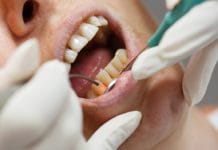The recent emphasis on the importance of a healthy diet and good nutrition has not been ignored by the dental profession. Vitamins and nutrients can have significant effects on the oral cavity. The patient’s medical history, clinical evaluation, and radiographs can reveal the negative effects of vitamin deficiencies and resulting oral manifestations.
The most common vitamins that are introduced and supplemented in the human diet are vitamin A, vitamin B, vitamin C, vitamin D, and iron (a mineral nutrient sometimes contained in vitamins). The presence of vitamins in a daily diet can facilitate positive effects for the body, such as improving digestion, boosting immune response, and facilitating bone growth, to name a few. However, a deficiency in these vitamins can have negative effects on the overall health of an individual.
Evaluating the dental patient during an extra- and intraoral examination may result in the detection of manifestations in the oral cavity caused by a vitamin deficiency. As a result, understanding the patient’s most recent oral habits, dietary intake, medications, and medical complications are important to ensure an effective diagnosis.
Vitamin A
Vitamin A consists of a combination of unsaturated nutritional organic compounds that are typically found in a variety of meats, fruits, vegetables, and dairy products. Vitamin A is important for growth and development, immune system maintenance, and vision.1 Roughly one-third of the children in the world under the age of five suffer from vitamin A deficiency, more commonly in underdeveloped countries.1
An indicator in children and adults of a vitamin A deficiency is impaired tooth formation, such as enamel hypoplasia which is a developmental defect affecting the permanent or primary teeth.1 It presents itself as pits, grooves, or missing areas of enamel caused by a defective enamel matrix formation during tooth development, thus giving the tooth a translucent appearance.3
Vitamin B
Vitamin B is a group of water-soluble vitamins important in cell metabolism.4 The most common Vitamin Bs that are metabolized and supplemented daily are vitamin B1, vitamin B2, vitamin B3, vitamin B5, vitamin B6, vitamin B7, vitamin B9, and vitamin B12. These vitamin B classes can be found in meats such as turkey, tuna, and liver, as well as in enriched flour products.
However, vitamin B is not commonly found in abundance in vegetables, thus causing concern for vegans. Vegans do not consume any animal products (meats and dairy products), which creates the condition for a vitamin B deficiency. Although vegans may have a high carbohydrate intake, only carbohydrates with “enriched flours” have the recommended daily intake of vitamin B.4
In addition, the elderly, athletes, diabetics, and pregnant woman are also at risk for a vitamin B deficiency. The elderly commonly have difficulty with absorption of the water-soluble vitamin B, and athletes tend to use more energy, therefore absorbing vitamin B at a higher rate. People with diabetes test with lower levels of thiamine (vitamin B1), and it is recommended that women during pregnancy add the supplement of folic acid (vitamin B9).4
Vitamin B deficiency can be detected orally as well. Vitamin B1 (thiamine) can be detected by cracked lips or angular cheilitis,2 a condition that can last for days or years and is detected by “inflammation of one or both corners of the mouth.”5 Also, vitamin B2 (riboflavin) and vitamin B3 deficiency can cause inflammation of the tongue, angular cheilitis, and ulcerative gingivitis.2
Other oral manifestations that can be detected as a result of vitamin B6 deficiency is periodontal disease, a burning sensation, and sore tongue.2 Lastly, vitamin B12 deficiency can show signs of angular cheilitis, halitosis, periodontal disease, hemorrhagic gingivitis, and painful ulcers in the mouth.
Vitamin C
Vitamin C is a water-soluble nutrient also commonly known as ascorbic acid. It is found in citrus fruits and some vegetables, such as broccoli and Brussels sprouts.6 Vitamin C is important in maintaining and repairing healthy connective tissue and has antioxidant properties.2
The most common oral symptom of a vitamin C deficiency is bleeding gingiva and gingivitis. Due to the many denominators that are in involved in gingivitis, understanding a patient’s health and diet is important in realizing that the cause of the symptom may be related to a vitamin C deficiency.
Vitamin D
Vitamin D is a fat-soluble nutrient that aids in the absorption of calcium and phosphorous from the foods consumed. Also, vitamin D “increases the production of antimicrobial proteins that fights bacteria causing decay.”7 Therefore, one sign of a vitamin D deficiency is an increase in caries.
Another sign of a vitamin D deficiency is a change in the pulp horns of a tooth in a radiograph from “U-shaped to a chair-shaped pattern that looks like a skinny ‘H’.”8 Furthermore, the lack of vitamin D may cause abnormal alveolar bone patterns and hypo-mineralization that compromises tooth integrity.
Iron
Iron is “a variety of iron formulations used to treat and prevent iron deficiencies” due to anemia, pregnancy, poor absorption, or heavy menstrual periods.9 The most common oral symptom of iron deficiency is a red, painful tongue with a burning sensation. However, angular cheilitis, dysphagia, and salivary gland dysfunction are also other symptoms of an iron deficiency.
The lack of proper nutrients and vitamins in a patient’s diet can have a detrimental effect on oral health and overall health. Although not all symptoms discussed may be related to a vitamin deficiency, knowing the patient’s medical history, daily dietary habits, and medications are important for properly understanding the presence of the symptoms. Recommending a visit to the patient’s primary care physician may be indicated if all the markers are present to properly connect the symptom to a vitamin deficiency.
Need CE? Click Here to Check Out the Self-Study CE Courses from Today’s RDH!
Listen to the Today’s RDH Dental Hygiene Podcast Below:
References
- Definition Vitamin A. Wikipedia. Retrieved from https://en.wikipedia.org/wiki/Vitamin_A
- Sheetal, A., Hiremath, V.K., Patil, A., Sajjansetty, S., S.R. Malnutrition and its oral outcomes. Journal of Clinical and Diagnostic Research. 2013 Jan:7 (1): 178-180. Retrieved from https://www.ncbi.nlm.nih.gov/pmc/articles/PMC3576783/
- Definition Enamel Hypoplasia. Wikipedia. Retrieved from https://en.wikipedia.org/wiki/Enamel_hypoplasia
- Definition Vitamin B. Wikipedia. Retrieved from https://en.wikipedia.org/wiki/Enamel_hypoplasia
- Definition Angular Cheilitis. Wikipedia. Retrieved from https://en.wikipedia.org/wiki/Angular_cheilitis
- Definition Vitamin C. Wikipedia. Retrieved from https://en.wikipedia.org/wiki/Vitamin_C
- Parasarathy, P., Priya, V., Gayathri, R. Relationship between Vitamin D and dental caries – review. Journal of Pharmaceutical Sciences and Research. 2016: Volume 8; 459-460. Retrieved from www.jpsr.pharmainfo.in/Documents/Volumes/Vol8Issue06/jpsro8061615.pdf
- Can Vitamin D Deficiency be Identified with Radiographs? Today’s RDH. 20 November 2017. Retrieved from https://www.todaysrdh.com/can-vitamin-d-deficiency-be-identified-with-radiographs/
- Definition Iron. Wikipedia. Retrieved from https://en.wikipedia.org/wiki/Iron_supplement












